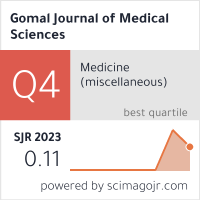ENDOTHELIAL DYSFUNCTION: A CARDIOVASCULAR RISK FACTOR
Naqab Khan, Najma Bibi, Zahid Rasul Niazi, Kifayatullah Shah, Syed Azhar Sherazi, Samiullah Khan
Abstract
Endothelium is one of the largest organ by area and consist of at least one trillion endothelial cells having more than 100 gram weight and covering more than 3000 square meters area in an adult human body. Endothelium interacts with most of the body systems and is implicated in end organ diseases particularly the cardiovascular. The endothelium maintains vascular tone by precisely regulating the vasodilatation and vasoconstriction while effectively providing the adequate supply of blood to the target organs. Factors that affect the endothelium and subsequently cardiovascular system include hypertension, smoking, obesity, hyperglycemia, hyperlipidemia, poor dietary habits and physical inactivity. Endothelial dysfunction is strongly associated with cardiovascular risk factors such as atherosclerosis, elevated level of low density lipoprotein oxidation, cytokine elaboration, up regulation of adhesion molecules, increased cell permeability, platelet aggregation as well as proliferation and migration of vascular smooth muscles. Endothelial dysfunction is a pathophysiological term used to indicate diminished production of nitric oxide and an imbalance in endothelial derived contraction and relaxation.
Refbacks
- There are currently no refbacks.
Copyright (c) 2020 Naqab Khan, Najma Bibi, Zahid Rasul Niazi, Kifayatullah Shah, Syed Azhar Sherazi, Samiullah Khan

This work is licensed under a
Creative Commons Attribution-NonCommercial 4.0 International License.

Gomal Medical College, Daraban Road, Dera Ismail Khan, Pakistan
ISSN: 1819-7973, e-ISSN: 1997-2067
Website: https://www.gmcdikhan.edu.pk
Phone: +92-966-747373








